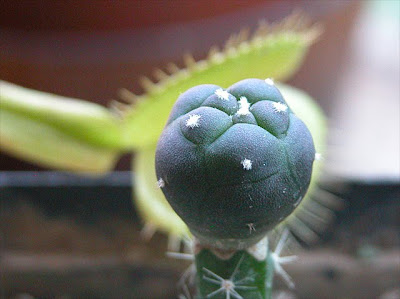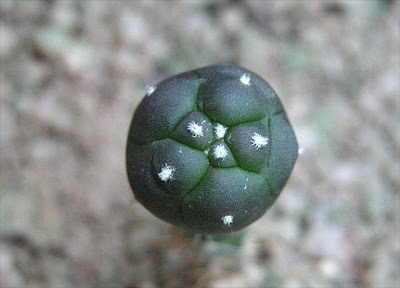It’s that time of year again. Most of my peyote plants have flowered freely all through summer and now the eagerly awaited results, the fruits, are appearing (many of my plants are still flowering so I’m hoping for a good seed harvest this year ;-)
Fortunately the majority of my coldhouse grown Trans-Pecos peyote plants (Lophophora williamsii var. echinata) survived this winter’s harsh frost (contrary to my “regular” Lophophora williamsii growing in the same unheated greenhouse – most of these plants succumbed to the frost).
Trans-Pecos peyote with fruit
The first fruit appeared on one of the surviving Trans-Pecos peyote plants only a few days ago. I’m looking forward to growing these seeds as the parent has a proven record of frost hardiness and I expect this trait to be inherited by its offspring (I’m using the singular “parent” as I assume this fruit to be the result of selfing; it only contained two seeds). Hopefully many of the cold grown Lophophora williamsii var. echinata plants will set fruit during the next couple of months ;-)
Trans-Pecos peyote with fruit, top view
I’ve been made aware that my use of the echinata epithet is not entirely clear. To clarify, I’m using it in the sense of Del Weniger – others, e.g. Backeberg, are incorrectly (IMHO) using echinata to describe what seems to be diffusa.
In his book Cacti of the Southwest Del Weniger describes L. williamsii var. echinata as being a larger, tougher form of the species, having heavier and larger stems and not clustering to any marked degree (possibly with a higher mescaline content also). Furthermore the echinata variety is described as being much more tolerant to extreme temperatures, both hot and cold (Weniger writes: “This form is found growing on dry, exposed hillsides of the Big Bend where the lower Rio Grande Valley form would be burned to a crisp. It can also survive the much more severe cold of the Big Bend. I have several times had the smaller form from south Texas freeze in San Antonio, while this form growing in the same bed showed no ill effects”). The range of the echinata variety is given as “Northern Mexico, extending from Chihuahua and Coahuila into the Texas Big Bend in lower Brewster County”.
Trans-Pecos peyote fruit, close-up
I have to admit that I find it rather difficult to clearly distinguish the echinata and regular williamsii forms based on morphology alone, especially young cultivated plants. So I rely heavily on locality information when buying seeds and to play it safe I prefer material originating from the Trans-Pecos region of Texas, the northernmost extreme of the Lophophora genus’ range.
But as my horrible experience this winter showed the echinata variety (in this case Lophophora williamsii var. echinata JJH 8608293; Pecos River area, Val Verde County, Texas) definitely seems to be more frost hardy than the regular williamsii variety.
Thursday, July 22, 2010
Trans-Pecos peyote with fruit – it’s an echinata!
Tuesday, July 13, 2010
Echinocactus horizonthalonius seedling pictures
Late May I started 20 Echinocactus horizonthalonius seeds (SB 409; Shafter, Texas) and for several weeks nothing happened. But lately it has been extremely hot in Denmark and these weather conditions seem conducive to the germination of E. horizonthalonius.
Echinocactus horizonthalonius seedling, close-up
Two days ago 5 Echinocactus horizonthalonius seedlings had germinated – 25% is not an impressive germination rate, I know, but still I'm quite satisfied as these seeds seem notoriously difficult to germinate (in my meager experience with Echinocactus anyway ;-) 
Echinocactus horizonthalonius seedling
I look forward to growing these plants and hope they with time will grow to look like the beautiful Echinocactus horizonthalonius specimen pictured below ;-)
Echinocactus horizonthalonius, San Luis Potosí
The above habitat photo is by Kauderwelsch and is licensed under the “Creative Commons Attribution-Share Alike” license. The original picture can be found at the Wikimedia Commons.
Sunday, July 04, 2010
Lophophora alberto-vojtechii grafted on Selenicereus grandiflorus stock
Shortly after posting on my lone Lophophora alberto-vojtechii seedling I was contacted by Jacopo who is also growing L. alberto-vojtechii. Jacopo started his seeds in three different batches and had germination rates ranging from 10% (like mine) to 45%; several plants were lost to fungal infections and algae, including a variegated L. alberto-vojtechii seedling, so Jacopo decided to graft some of the plants on Selenicereus grandiflorus stock for safekeeping. Below you can find a few pictures of his plants – all photos in this post are courtesy of Jacopo Simonetto, Valencia, Spain.
Lophophora alberto-vojtechii grafted on Selenicereus grandiflorus
Jacopo has five L. alberto-vojtechii plants in total – 3 grafted on Selenicereus grandiflorus stock plants and 2 on their own roots. He hopes that his two largest plants reach flowering size this summer (they are already 1 and 1.5 cm in diameter) so he can test the germination rate of verifiable fresh seeds ;-)
Two Lophophora alberto-vojtechii seedlings grafted on Selenicereus grandiflorus stock plants
As an aside, I really like the carnivorous plants in the pictures – especially the Dionaea muscipula (Venus Flytrap) in the first photo that seems just about ready to gulp down the defenseless Lophophora alberto-vojtechii seedling ;-) Also, the Drosera (Sundew) in the second image reminded me that I need to get a few of these plants to help me control the fungus gnats that are having a feast in some of my (non-cactus) plants. 
Grafted Lophophora alberto-vojtechii, top view
Jacopo’s plants were started from seed 4-5 months ago and the grafts are 3 months old at the time of writing. I hope to be able to follow the plants as they (with a bit of luck ;-) flower and set fruits in the near future.
For comparison a picture is included below showing one of the seedlings still growing on its own roots – it’s relatively small but Jacopo told me that he grafted the biggest seedlings.
Lophophora alberto-vojtechii seedling
All Time Most Popular Posts
-
On various occasions I've been asked what growing media I'm using for my cactus plants. I don't have a set soil mix recipe as su...
-
Lophophora williamsii (peyote) populations have diminished in large areas of South Texas where peyoteros harvest the cactus for ceremonial ...
-
Below is a list of retailers/nurseries selling cactus seed and plants. I've only listed vendors I've done business with. If you ar...
-
Most cacti are easily grown from seed - and with a little patience and care they can be grown into beautiful plants. Lophophora williamsi...
-
In last month’s post on the troubled Texan peyoteros I referred to Anderson’s article on the peyote situation in Texas. Given the importanc...
-
Yet another slightly off topic and probably not entirely politically correct post, but I couldn’t help noticing the similarity of my monstr...
-
Flowering stand of San Pedro cacti (Trichocereus pachanoi) To me the main draw of the San Pedro cactus ( Trichocereus pachanoi (syn. Ech...
-
In the June 2008 issue of the Cactus & Co magazine Jaroslav Šnicer, Jaroslav Bohata, and Vojtěch Myšák described a new Lophophora spec...
-
There seems to be an increased focus on the alarming Texas peyote situation. A couple of weeks ago the Houston Press published a mournful, i...
-
I spent two weeks working in Delhi, India during January. I had one weekend off and had planned to spend it in Delhi at my own leisure, but ...


















